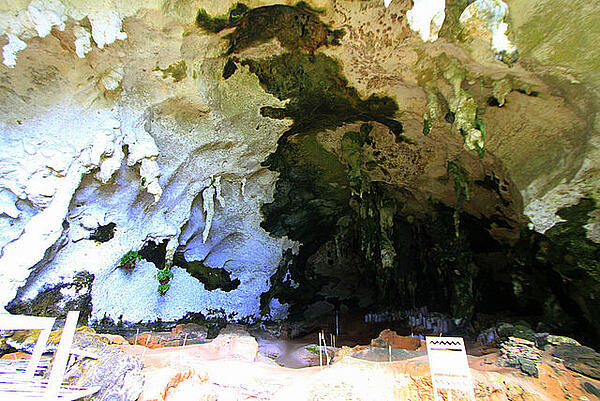Tabon Man
The Tabon Man is the oldest confirmed modern human to have been found in the Philippines. His bones, which provide evidence of the existence of Home sapiens between 37,000 and 47,000 years ago, were discovered in the Tabon Caves in Quezon, Palawan Island in 1962.
While later discoveries - including that of the Callao Man and the revelation of animal remains in Rizal - have hinted to early man finding their way onto the archipelago up to 709,000 years ago, Tabon Man is still the only confirmed example of modern man found on the island to have been dated back to the Stone Age.

Unearthed by anthropologist Dr Robert Fox, the skull bone and jaw of three different individuals were found in the Tabon Caves, as well as a mandible and teeth. These remains were surrounded by evidence of stone tools and charcoal left from three assemblages of man-made fire (dated back to 7,000, 20,000 and 22,000 years ago, respectively). This evidence suggested that this early version of modern man were hunters and gatherers rather than farmers, searching for food rather than cultivating it themselves.
However, other discoveries made in the cave system have revealed that the Tabon people were relatively advanced in their knowledge and thinking, with evidence including the discovery of human remains in earthenware jars pointing to the practice of human burial.
In terms of the Tabon Man himself, analysis of the bones found that the skeletal remains were not Negrito. As a Negritos were among the first settlers in the Philippines, having arrived 30,000 years ago, this poses the question of how the Tabon Man came to live on the island.
According to some, the Tabon remains are those of a pre-Mongoloid race. Mongoloid is the term used to describe people who entered Southeast Asia and absorbed different types of early man to produce the modern Malay, Indonesian, Filipino and Pacific people. However, other experts argue that the mandible discovered among the remains is of Australian type, with skullcap measurements that match those of the Ainu people or Tasmanians who inhabited the island tens of thousands of years ago.
Archaeologists and anthropologists continue to dig in the caves, which have been dubbed the Philippines’ Cradle of Civilization due to the huge number of discoveries that have been made there. However, so far only 29 of the 215 caves that are known to make up this cave system have actually been explored. Despite this, the discovery of the Tabon Man and the implications it has on the plotting of human history has been so great that the cave complex has already been added to the tentative list of the Philippines for future UNESCO World Heritage Site nominations.
MLA Citation/Reference
"Tabon Man". HistoryLearning.com. 2025. Web.
